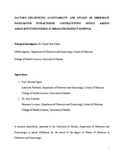| dc.description.abstract | There are over 18 million births among adolescents every year. These mainly occur in the
developing countries and are linked to poor socio-economic status, lack of sex education, early
marriages, repeat unintended pregnancy and low contraceptive use. Adolescent pregnancies are
preventable with contraception but, among those able to access family planning, there’s a
preference for short acting methods with lower continuation rates and higher failure rates with
typical use. Long acting reversible contraceptives like intrauterine contraceptive devices
(IUCDS’) have great potential to prevent unintended pregnancies. However, IUCD use in Kenya
is at an extreme low and it is also unclear whether adolescent mothers would be willing to use
the method within the postpartum period.
Objective: To determine factors influencing acceptability and uptake of immediate postpartum
intrauterine contraceptive device among adolescents who have delivered at Mbagathi District
Hospital (MDH).
Methodology: Cross-sectional study among adolescent mothers delivered at Mbagathi District
Hospital. Consenting eligible adolescents were consecutively enrolled and completed a
structured questionnaire that assessed socio demographic status, knowledge and use of family
planning (FP). Counseling on FP was done and a postpartum intrauterine contraceptive device
(PPIUCD) offered. Those who consented had the IUCD inserted within 24 hours of placental
delivery. Data collected was analyzed using SPSS software version 17 to determine the
acceptability and factors influencing acceptability, to determine insertion rate and the proportion
of early complications post immediate PPIUCD insertion. Categorical data were analyzed by Chi
square and Fischer’s exact tests and continuous variables were assessed by the student’s t-test.
Results: Of the 117 adolescents enrolled, 14(12%) were willing to use PPIUCD in future but
only 6(5.1%) had the PPIUCD inserted. Adolescents between age 14-16 were more willing to
accept the method compared to17-19 years (OR 0.16, 95% CI 0.05-0.52). There was no
significant statistical difference in the socio-demographic and reproductive characteristics among
the acceptance or uptake arms of the PPIUCD and those who declined the method. The
commonly cited reasons for declining the PPIUCD was lack of interest in a FP method 66(56%)
and lack of PPIUCD awareness 26(22%). The most common cited reason for willingness to use
the PPIUCD was its long term pregnancy protection. Among the six who had the PPIUCD
inserted, the post insertion complications reported within the first two week clinic follow up
were abdominal pain 3/6, and misplacement 1/6. Complementarily, 4/6 (67%) mothers were
satisfied with the method and would recommend it to other adolescent mothers.
Conclusion: We found low acceptability and uptake of PPIUCD among adolescent mothers.
Generally, there was lack of awareness and low prior use of the IUCD, lack of interest in FP
among sexually active adolescents, myths, misperception and fear of complications cited as the
barriers to use PPIUCD.
Recommendation: Adequate information on the risks of teenage pregnancies, family planning
methods especially the long acting reversible contraceptive methods should be provided to
sexually active adolescents during antenatal and postnatal care. | en_US |
| dc.description.department | a
Department of Psychiatry, University of Nairobi, ; bDepartment of Mental Health, School of Medicine,
Moi University, Eldoret, Kenya | |

